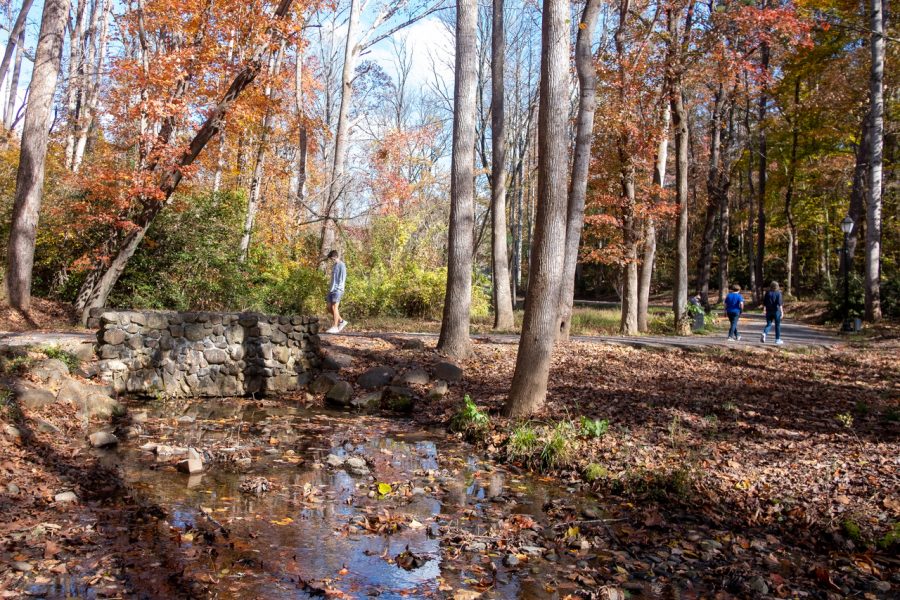It must be something in the water: E. coli
Recurring rains have carried human waste from the Reynolda campus to nearby water streams
November 12, 2020
As senior Anna Shutley tip-toed from rock to rock along the stream adjacent to the Reynolda Trail near campus, she lifted rocks in search of reptiles and amphibians for her herpetology class. She found tadpoles, turtles, crawfish and slimy salamanders. Shutley was surprised to hear that another organism, this one unseen, was in the water at her feet: E. coli.
When it rains, oil from leaking cars in Lot Q, fertilizer put on the grass around North Campus Apartments, soda cans littered near Scales and neglected dog waste all flow into the stream along Allen Easley St.
“I had seen trash in the stream and knew it wasn’t the cleanest, but E. coli means poop!” Shutley said in disgust. “And kids play in there!”
According to the National Oceanic and Atmospheric Administration, the leading cause of water pollution is storm runoff. As climate change continues to cause more frequent and larger rain events, stormwater management is becoming increasingly important, especially on campus.
In 2017, as Hurricane Harvey struck Houston, 60 inches of water overwhelmed the water management system and flooded the urban area, leaving $125 billion in damage. Engineers concluded the flooding was mainly a result of 40% of the ground in the city being covered by impervious surfaces.
“When it rains, the best possibility is for the rain to soak into the ground where it landed,” said Courtney Di Vittorio, a professor of engineering teaching a class in water management. “When water cannot soak into the ground, it will flow downhill.”
The 1914 Soil Survey of Forsyth County found the soil around Winston-Salem to have excellent, even excessive drainage. However, soil cannot help much when a five-acre parking lot covers it.
“Lot Q is a really large impervious surface,” said Tony Schallert, the university’s infrastructure and utility engineer.
“All of the water and any debris on the surface goes through a 24-inch pipe and dumps into the stream. There’s no filtration.”
Chris Zarzar, a former assistant research professor of biology, worried that this may affect wildlife on campus and downstream. Zarzar collected water samples from the stream and where the water flows, Lake Katherine at Reynolda Village, this summer and found unusually high concentrations of E. coli and heavy metals.
“High values in those streams would most likely be the direct result of on-campus activity,” Zarzar said. “This is concerning for amphibian species because high concentrations of heavy metals in the water are toxic to amphibians.”
Other biologists agreed. Dave Anderson, a professor of biology, feared that the lack of runoff filtration may harm students and our neighbors along the stream.
“Anyone with a small cut or anyone who gets water in their mouth could face a serious intestinal problem,” Anderson said. “Wild E. coli are much more virulent than the strains we normally experience.”
While the lack of stormwater management systems along the stream likely has a cost on the environment, it also costs the university. Excessive amounts of flowing water cause erosion of the stream banks that could impact buildings and infrastructure on campus.
“Not only do we have to worry about Lot S falling into the stream,” Schallert said. “But the dance studio behind Scales is awfully close to the stream, too.”
Partial emergency repairs to reinforce the stream banks along part of Lot S, which is 300 meters downstream of Lot Q, have cost $100,000. Estimates to finish the Lot S repair and reinforce the stream banks behind Scales predict a $1 million price tag.
Ideas to address the financial and environmental effects of stormwater runoff have been floated.
Anderson suggested that Lot Q be paved in part with porous concrete, but admitted it would likely be very expensive to renovate and maintain. Di Vittorio said a retention pond or rain garden would help reduce the quantity of water and improve the quality by filtering pollutants.
“I’d love if we could filter the water and we even developed a plan for a retention pond in the stream,” Schallert said. “But the Corps of Engineers said, ‘No, you can’t mess with the stream.’”
Although Wake Forest’s 1952 construction did not prioritize stormwater management, Schallert said that the Facilities & Campus Service Office is implementing improvements where they can.
The Byrum Welcome Center, for example, has a series of water retention tanks that run water through a layer of sand to filter it and slow its flow. On the east side of campus, water flows through a series of tiered ponds behind Angelou Hall before entering Lake Katherine.
This is a helpful start, but as Shutley now searches the woods for her herpetology class, she is sure of one thing, “I’m not going in that water again.”












